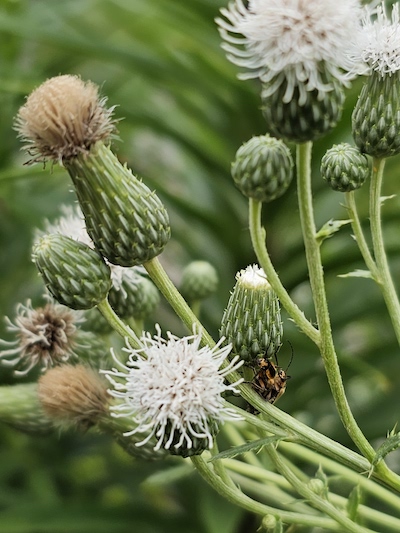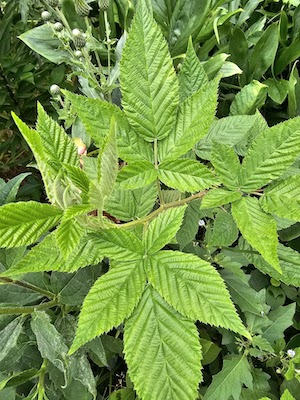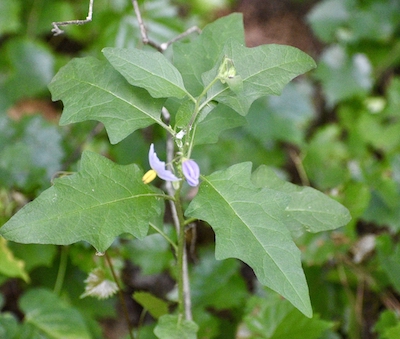What Are My Weeds Telling Me?
by Ann M. Mason, Fairfax Master Gardener

Perennial creeping thistle (Cirsium arvense)
It is summer and perennials in my landscaped front beds are lush with vegetation. Along with my desired perennial plants, the weeds are bursting forth. Specifically, my garden has some problematic perennial weeds such as creeping thistle (Cirsium arvense, also called Canada thistle or field thistle), brambles (Rubus spp.) and Carolina horsenettle (Solanum carolinense). These thorny weeds are mixed in with plantings of azaleas (Rhododendron sp.), black and blue salvia (Salvia guaranitica), scarlet beebalm (Monarda didyma), black-eyed Susan (Rudbeckia hirta) and blue flag iris (Iris virginica).
The Canada thistle is a member of the sunflower botanical family (Asteraceae) and while the bees love the nectar, this thistle is an invasive, creeping, terror of a plant. Carolina horsenettle is a member of the nightshade botanical family (Solanaceae) and is a native perennial that will sprawl (if not controlled) over all other plantings with its prickly leaves and stems. The brambles (Rubus spp.) are members of the Rosaceae botanical family that include dewberries, blackberries and raspberries. However, I have not seen fruit on these unwanted plants largely because I cut the vegetation prior to flowering. All these thorny plants are annual visitors in the same sunny bed facing my front door. So far they have ignored my attempts to manage them.
Many gardeners view “weeds” as plants in the wrong place. For me these three are exactly that — in the wrong place. However, veteran gardeners observe that weeds favor specific soil conditions and write that plants in the wrong place are trying to repair localized soil conditions. The American botanist Frederick Clements (1874-1945) reportedly said, “Each plant is an indicator. This is an inevitable conclusion from the fact that each plant is the product of the conditions under which it grows and is thereby a measure of these conditions. As a consequence, any response made by a plant furnishes a clue to the factors at work upon it.” Assuming that these three thorny weeds are trying to signal the health of the soil in this garden bed, what are these plants trying to signal? In this article, I take you on my journey to figure out what these weeds are signaling.
Australian botanist Gwyn Jones divides “weeds” into categories and functions or roles the plant seems to provide the soil.
- Cover the ground. This includes plants covering bare, disturbed soils with weeds acting as colonizers, first out of the ground pioneers, or plants defending the soil by growing over poor groundcover plants. These defenders include plants with slow growing thick-walled plants, plants with very tough leaves and stalks and plants with thorns and spikes.
- Raise the successional order to build soil and its quality. These plants either act to build topsoil because of compaction, mineral depletion and poor soil structure or to regulate nitrogen. Plants in this group include ones with tap roots, deep roots, underground storage, fine roots or roots that fix nitrogen.
- Regulate excess nutrients to rebalance the soil. This group has two subgroups: plants that regulate nitrogen with their fast-growing broad leaves or spread thickly, or have umbrella-like foliage over the ground; and plants that renovate the ecosystem by making a canopy, climbing and smothering other plants, or slow and filter soluble nutrients.
Botanists have identified specific weeds as ‘indicators’ of soil health, that is, looking for weed plants and communities that grow only where their particular needs are met. Weeds that are highly adaptable do not serve as good indicators. Several universities, including the University of Connecticut, University of New Hampshire, Michigan State and Clemson, offer some key weeds to identify low fertility soils: acidic soils; wet soils; drought-prone soils; compacted soils; heavy shade; and high fertility soils. These are compiled into a Indicator Weeds Table.
Michigan State provides indicator weeds on mineral soil deficiencies:
- Redroot weeds, such as redroot pigweed (Amaranthus retroflexus), are signs that the iron-manganese ratio is out of balance. It may indicate there is too much iron or too little manganese. It also indicates a soil that is very high in potassium and manganese and low in phosphorus and calcium.
- Quackgrass (Elymus repens) is a sign of improper iron-manganese ratio.
- Bitterweed (Helenium tenuifolium), trumpet vine (Campsis radicans), broom sedge (Andropogon virginicus), stinging nettle (Urtica dioica), horsetail (Equisetum arvense) and wild buckwheat (Polygonum convolvulus) may all indicate a calcium deficiency in the soil.
- Wild buckwheat (Polygonum convolvulus) also signifies low phosphorus and an excess of potassium.
- Burdock (Arctium lappa) indicates low calcium, high potassium soils.
- Curly dock (Rumex crispus) loves compacted soil, low calcium and extremely high magnesium, phosphorus and potassium.
- Lambsquarters (Chenopodium album) grows in low phosphorus, high potassium soils.
- Foxtail barley (Hordeum jubatum) likes low calcium, high magnesium, as well as compacted and poorly drained soil.
- Knapweed (Centaurea maculosa) grows in soils that are low in calcium, humus and very low phosphorus levels.
- Oxeye daisy (Chrysanthemum leucanthemum) prefers to grow in soils that are low phosphorus, high potassium and high magnesium soils.

Brambles (Rubus spp.)
Returning to the three thorny plants in my sunny front garden bed, none are on the university lists for soil indicator weeds.
As a bit of history, this bed was initially deeply tilled during the first three growing seasons over 40 years ago. A lot of construction debris and rocks were removed, and soil amendments added. The bed’s initial planting focused solely on evergreen Andorra compacta Juniper (Juniperus horizontalis) typical of 1980s yards. Desiring more flowers, in the 1990s, we replaced the junipers with white flowering azaleas that suffered and limped through the hot summer sun but did not thrive. In the early 2000s, we transitioned to an informal garden by adding more native and heat loving herbaceous flowering plants into this space. The ground was never tilled during these successive plantings. Compost and soil were added to replace the soil depleted with the removed plants. The last pH test for this bed was 6.2, typical for the rest of the yard. The bed is densely planted. Much to our chagrin, our native birds or turtles granted us mock strawberries (Potentilla or Duchesnea indica), a member of the Rosaceae botanic family. These ground hugging plants cover the soil throughout this bed and are pulled out each year with no seeming reduction in population density.
So, what are the shared characteristics for these three thorny plants, Carolina horsenettle, brambles and thistle? First, each of these plants bear thorns suggesting that they are defenders of the soil. Second, each of these plants are characterized by deep tap roots suggesting that they are working to pull minerals up through the Virginia clay mixed earth that the contractor used to fill the front yard when the house was built over forty years ago. Third, they are well suited to growing in this sunny landscaped bed.

Carolina horsenettle
In her article, What your weeds are telling you, Eileen Tully, Colorado Master Gardener, wrote that “Thistle is an indication your soil needs more acid. This can be achieved with soil amendments like ferrous sulfate or aluminum sulfate. A soil test will indicate how much will be needed to apply.” Since it has been over three years since a soil test was done on this bed, this is a good place to start.
Cornell scientists have extensive fact sheets on two of these weeds. They describe Carolina horsenettle as a very adaptable weed that grows in almost all soils and sunlight conditions except deep shade. Cornell reports that Canada thistle has a deep root system that also serve as storage roots making removing of this thistle a difficult challenge requiring persistence.
At the moment, the battle continues. As I research non-chemical management controls, I will continue to limit the vegetative growth for each of these plants hoping to deplete the vigor of the roots. As my last option, the 2023 VCE Pest Management Guide does offer a chemical management approach that will be added to the overall plan.
References
• What Are My Weeds Telling Me, Ann M. Mason, Fairfax Master Gardeners
• Weeds as Indicators of Growing Conditions in Landscapes, Victoria Wallace and Alyssa Siegel-Miles,
University of Connecticut Extension
• What can weeds tell me about my garden soil?, University of New Hampshire Extension
• Weeds are an indicator of a soil’s health, Dixie Sanborn, Michigan State University Extension
• What Your Weeds Are Telling You, Eileen Tully, Colorado Master Gardener, Colorado State
University Extension
• Weeds as Indicators¸ Jackie Jordan, Clemson Cooperative Extension
• Horsenettle, Solanum carolinense, Weed Science, Cornell College of Agriculture and Life Sciences
• Canada thistle, Cirsium arvense, Weed Science, Cornell College of Agriculture and Life Sciences